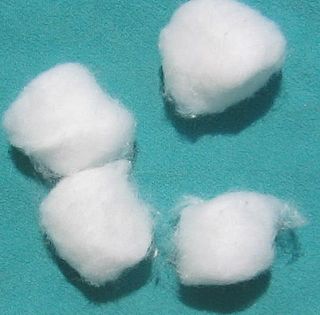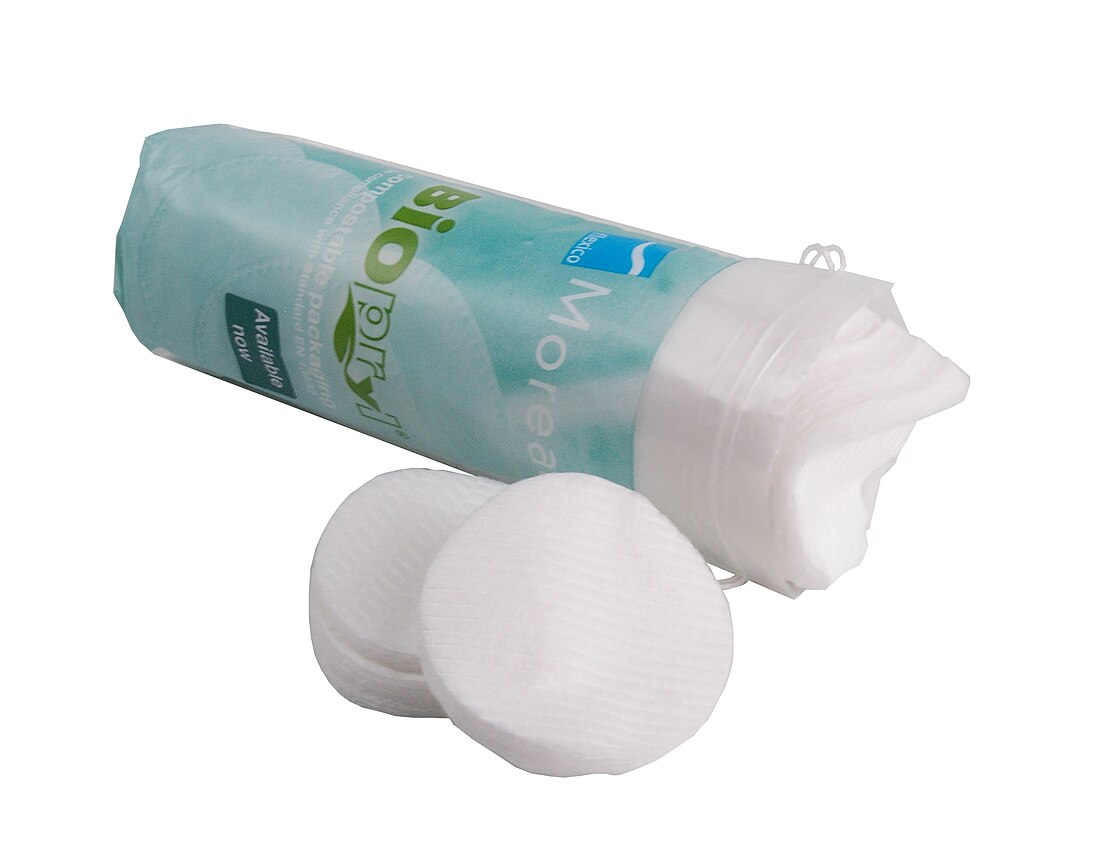Cotton pads are pads made of cotton which are used for medical or cosmetic purposes.[1] For medical purposes, cotton pads are used to stop or prevent bleeding from minor punctures such as injections or venipuncture.[2] They may be secured in place with tape. Cotton pads are also used in the application and the removal of makeup.[1] Cotton pads are soft enough that they can be used to clean babies.[1] Cotton balls have much of the same applications as cotton pads, and can be used interchangeably [citation needed].


History
Use of cotton for sanitary purposes likely dates back to its domestication. There is evidence that toilet paper, made in part of cotton and/or other plant fibers such as hemp,[3][4] was used at least as early as 589 AD in China.[5][lower-alpha 1] Cotton balls have been used for applying gold leaf since at least as far back as 1801. An artists' manual from that year recommends using a "squirrel's tail, or cotton ball" to press the gold leaf into place.[6] There is some evidence that they were being mass produced as far back as 1816, namely an advertisement taken out of the New York Evening Post by Palmer, Nichols & Co. for many different kinds of fabric and products made of cotton which lists "Cotton Balls" as an item for sale.[7] In 1891 The Laredo Times ran a story about women who put cotton balls in their cheeks to make themselves appear less thin.[8] An 1898 patent by Jerome B. Dillon for a new type of umbilical bandage used an "antiseptic, absorbent cotton pad" to carry out its function.[9]
In 1937, Joseph A. Voss invented a machine which unraveled rolls of cotton and cut them at a fixed interval into cotton pads,[10] starting the widespread consumption of cotton balls and pads. Companies producing cotton balls took out ads in newspapers as early as 1948 to promote their uses to the public.[1] In 1965, the Opelousas Daily World reported that the sanitary cotton industry in the United States was worth US$60 million (US$460.4 million in 2016 CPI-adjusted dollars).[11] Around this time, there was industry concern that sanitary products using nylon, labeled as cotton balls, were going to crowd out cotton balls actually containing cotton, harming cotton-exporting regions.[11] In 1986, Johnson & Johnson, a manufacturer of cotton balls, published advertisements stating that "doctors advise" cotton balls over "synthetic puffs".[12]
In 2015, Mass Market Retailers, a supermarket and chain store trade magazine, estimated that combined sales of cotton balls and pads in the United States were US$177.7 million for the year 2014,[13] down from US$343.1 million in 1999.[14] The change could be due to increases of sales of cheaper store brands: in 1999, only 50.1% of sold cotton balls were store branded,[14] versus 83.7% in 2016.[13] The top three cotton ball brands in the United States in 2016 were Swisspers (manufactured by U.S. Cotton), Swiss Beauty (U.S. Cotton),[15] and Cotton Cloud (Wabbit, Inc.).[13]
See also
References
Wikiwand in your browser!
Seamless Wikipedia browsing. On steroids.
Every time you click a link to Wikipedia, Wiktionary or Wikiquote in your browser's search results, it will show the modern Wikiwand interface.
Wikiwand extension is a five stars, simple, with minimum permission required to keep your browsing private, safe and transparent.
